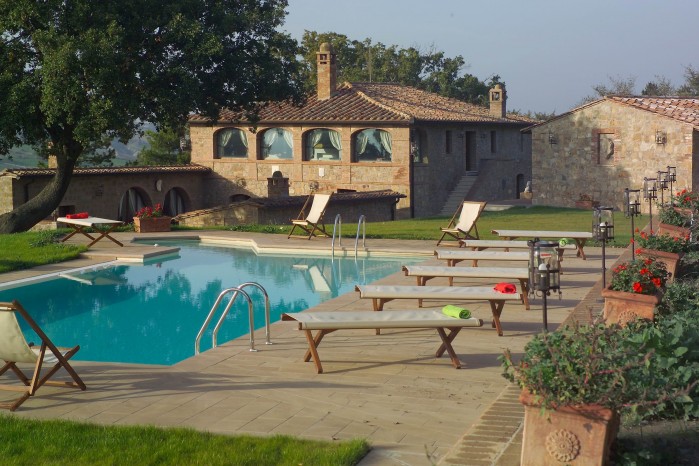Val d'Orcia
A breathtaking place where one can spend one’s holiday in outstanding Tuscan villas: this is the Val d’Orcia. A wonderful land dotted with striking farmhouses on the top of small hills or located in a lovely valley which have been mostly renovated and converted into comfortable apartments for rent in Tuscany. But this area is something more: a valley of gentle hills, occasionally broken by gullies, the Val d’Orcia is a cradle of history, culture, memorable wines and emotions. It is a landscape of hills, furrows and cypresses which proudly crown isolated farms or outline uphill, winding roads. An image which has become familiar through its depiction in works of art stretching from the Renaissance paintings to the modern photographs, for this reason in 2004 it was added by UNESCO to its list of World Heritage Sites. On the hills, hamlets of extraordinary charm overlook oak woods, olive groves and vineyards where the Brunello di Montalcino, counted among the most prestigious of Italian wines, is produced.
The river, from which the area takes its name, is just a stream, generally drying up in the summer heat. Springing from the hills near Radicofani and Sarteano, it later winds westward, skirting the hills of Pienza, San Quirico and Montalcino. The waters streaming on the surface shape the landscape and the ones springing from the heart of the volcano offer the visitor the wellbeing and the pleasure of the spa waters at Bagno Vignoni and Bagni San Filippo.
A visit to some of its picturesque towns and villages is worthwhile.
Pienza was rebuilt as an “ideal town” in the 15th century under the patronage of Pope Pius II, earning the definition of “touchstone of Renaissance urbanism”, and for this reason has been designated in 1996 a World Heritage Site. In fact, in 1458 Aeneas Silvius Piccolomini, who was later to become Pope Pius II, decided to transform his childhood home into a symbol of the Italian Renaissance. In three years, from 1459 to 1462, the town became an architectural landmark, thanks to the Assunta Cathedral and to Palazzo Piccolomini, characterized by a loggia, offering a spectacular view over the Val d'Orcia.
Montalcino is small town situated on a hill covered with olive groves and the famous vineyards producing the Brunello. It is the wine of kings and the king of wines, offering constantly evolving olfactory notes and a nervous yet full bodied flavour, able to challenge time and to remain timeless. Inhabited in Etruscan and Roman times, Montalcino became a commune and later fell under the influence of Siena and Florence. Surrounded by walls, it offers on its highest point a pentagonal plan fortress, which incorporates other structures, such as the keep of Santo Martini, the San Giovanni Tower and an ancient basilica, now the fortress chapel. Following the narrow, short street from the main gate of the fortress one encounters the Church of Sant’Agostino with its simple Romanesque façade. Next to this is a one-time convent, today home of the Civic and Diocesan Museum holding various masterpieces, including a Virgin and Child by Simone Martini and a St. Peter and St. Paul by Ambrogio Lorenzetti. The charming medieval Piazza del Popolo houses the magnificent Palazzo dei Priori, fine example of Sienese architecture, as well as a structure with six round arches called La Loggia.
One of the most important European pilgrim roads, the Via Francigena, crosses the hills and passes under the cypresses of the Val d’Orcia. In the Middle Ages extraordinarily fascinating churches and abbeys were built around this road. An example is Saint's Antimo's Abbey, one of the most important Benedictine monasteries in Tuscany, originally commissioned also to act as a hotel for the pilgrims directed to Rome. A tradition, unconfirmed by historians, has it that Charlemagne, between 774 and 781, received from pope Hadrian I the relics of Saints Sebastian and Anthimus, and then donated them to the abbey when it was founded: the abbey of Sant'Antimo, which strongly recalls the great French Romanesque churches. Of the Carolingian edifice, the apse and the portal, richly decorated with animal and vegetable motifs, are visible. Also, typically French in inspiration, is the ambulatory with radial chapels. Notable is the so-called capital of Daniel in the Lions hole, work of the French Master of Cabestany, which shows, on one side, Daniel praying between the hungry lions and, on the other sides, the lions devouring the accusers.
Further southeast, at the southern border of Val d'Orcia lies a highly impressive fortress, a gateway from the Grand Duchy of Tuscany to the Papal territories, this is the main landmark of Radicofani. Though the site was used by the Etruscans and Romans, the fortress, of Carolingian origin, was built only shortly before the year 1000. Home to the notorious 13th century outlaw, Ghino di Tacco, it has been modified several times and, in the 16th century, reinforced with bastions capable of withstanding artillery fire. Its tower, rebuilt in the 20th century, offers an extraordinary view over Val d’Orcia, Amiata, the Apennines and the Trasimeno and Bolsena lakes. The 13th century San Pietro and Sant’Agata churches contain a considerable collection of Della Robbia terracotta works and wooden statues.
Visit this fresh and unspoilt area, one of Siena's most precious treasures.













